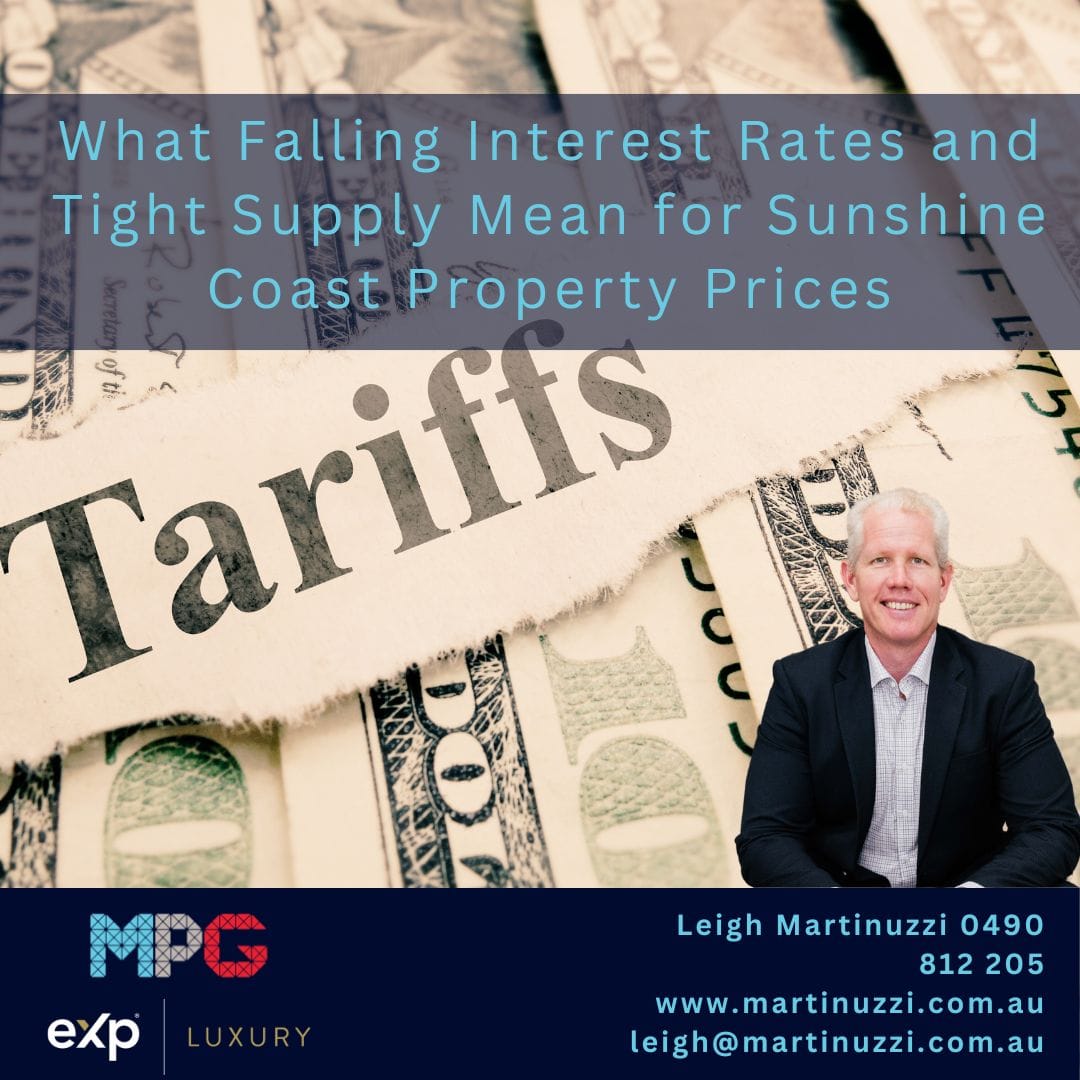What Falling Interest Rates and Tight Supply Mean for Sunshine Coast Property Prices
by Leigh Martinuzzi – MPG with eXp Australia
It’s been another interesting week of property research and opinion, and I kicked things off by diving into Matusik’s latest article. I’ve always enjoyed reading his work—it’s sharp, bold, and well researched. His take this week focused on the current inflation concerns being fanned by media headlines about the U.S. pushing tariffs and what that might mean for us here in Australia. Now, I don’t usually get too deep into politics (it can divide us more than bring us together), but I do think it’s worth keeping an eye on how these big-picture moves might ripple through to our local economy—and more importantly, to our housing market.
The RBA chose to hold the cash rate at 4.1% at their most recent meeting, but Matusik wasn’t impressed. He thinks it was a poor decision, as while inflation has been softening there are concerns with the new USA tariffs that we may see a reverse trend and inflation start to rise again. He even raised the possibility of an emergency meeting or a more aggressive rate cut—maybe even 0.5%—when they next meet in May. And here’s the kicker: if the cash rate does fall, we’re looking at improved borrowing capacity. Matusik reckons a 0.25% drop would increase borrowing power by 2–3%, which could mean an extra $15,000 in a buyer’s pocket. That might not sound like a lot, but when you multiply that across a competitive buyer pool in an undersupplied market, it’s enough to push prices higher again.
Since COVID, property prices across many Australian markets have already surged—up 40–50%, and in some areas more like 60%. And while some of us thought we were getting close to the peak, it just keeps moving. I’ve seen this firsthand on the Sunshine Coast. Prices felt like they were levelling off late last year, then suddenly bounced again with recent sales well above market averages. It really does feel like this boom has more legs and indeed we may just be in the middle of a “super cycle,” one of those rare extended periods of significant property growth.
But as always, it’s a balancing act. The good news in CoreLogic’s April update is that we’ve seen modest growth nationally—dwelling values rose 0.7% over the quarter and 3.4% over the past year. While that shows some strength, the momentum has definitely cooled in recent months. Brisbane and Adelaide are leading the charge among capitals, with annual growth of 8.6% and 11% respectively, while Perth surged 11.9% over the same period. Meanwhile, Melbourne (-2.6%) and Hobart (-0.4%) are still in the red. Even Sydney’s growth has eased, up just 2.6% year-on-year.
Sales activity has also started to stabilise, but listings remain tight. Total advertised listings are still 11% below the five-year average, and new stock is 4.1% lower than typical for this time of year. It’s a supply story through and through. Until we see more stock coming to market, prices are likely to hold or keep rising—especially if interest rates fall further. And let’s be honest, we’re not building enough homes. Approval levels are still below long-term averages, and labour and material constraints are keeping development subdued.
Affordability continues to be a serious issue. CoreLogic shows that national housing values are now sitting at a record value-to-income ratio, and the average mortgage holder with a 20% deposit is spending over 50% of their gross income on repayments. Combine that with slowing wage growth and higher living costs, and we’re facing a growing challenge.
Rents have also been on the rise—up 3.8% nationally over the year to March—and over the past five years, rental prices have jumped 38.4%, while wages have only grown by 15.4%. That’s not sustainable. It’s no wonder more renters are struggling, and many first-home buyers are finding it harder and harder to get into the market. In my opinion, the government needs to step in and provide serious long-term strategies to address this housing crisis. Short-term promises just won’t cut it anymore.
So where does that leave us? Well, demand is still outpacing supply, particularly in lifestyle markets like the Sunshine Coast. We’re seeing buyers relocating from the cities in search of more space, better lifestyle, and more value—keeping our region above the curve. As interest rates fall and borrowing capacity improves, we can expect more of the same. Whether this growth pace continues long term remains to be seen, but for now, the fundamentals remain in favour of a strong property market.
As always, if you’re considering making a move or just want to know where your property sits in today’s market, feel free to reach out. Let’s chat.
Thinking of selling? Let’s have a chat—I’d love to help you take the next step. You can schedule a free consultation here.
If you are in buying or selling mode I’ve also created this free resource – Sunshine Coast Home Sellers and Buyers Guide.
Make you SUBSCRIBE to stay up to date with all the latest property insights and new. Click Here.
“More Than Just Selling—An Exceptional Experience.”
Your Property | Your Story | Our Expertise
Your Dream Move is Closer Than You Think!





